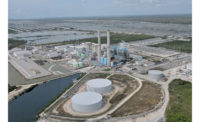Hypersaline cooling-water seepage from Florida Power & Light Co.’s 3550-MW Turkey Point Power Station in Florida City has polluted the shallow Biscayne Aquifer and soon will be drawn back to the plant’s property through retraction wells in an operation expected to take 10 years. The utility has begun construction on up to six other wells to tap the Floridan Aquifer for power-plant cooling, while state and county regulatory authorities are studying the utility company’s comprehensive plan for the groundwater cleanup. Approval of the plan is expected by early July.
Last summer, amid arguments over responsibility for the plume, Miami-Dade County commissioned a report on the problem to get an independent view (ENR 3/14 p. 8). David A. Chin, professor of civil and environmental engineering at the University of Miami, conducted the study and published the final report in mid-May. The report states “there is little doubt” that seepage from Turkey Point’s cooling canal system caused the salinity problem in the aquifer. On May 17, FPL submitted its remediation plan to the Florida Dept. of Environmental Protection and the county’s Dept. of Environmental Resource Management.
The recovered groundwater will be pumped 3,000 ft deep into what USGS describes as “an extremely permeable, cavernous zone.” Used in the wastewater industry, it “is an appropriate alternative,” says Wilbur Mayorga, chief of the county’s Environmental Monitoring and Restoration Division.
The origin of the salinity problem remains in dispute. Critics claim engineers failed to anticipate the increased heat rejection from a recent 225-MW uprate of the plant’s nuclear reactors. The retirement of fossil-fueled 400-MW Unit 2 resulted in a net reduction in heat, says Peter Robbins, FPL spokesman. But Chin’s report asserts, “Nuclear-power units are known to have much higher heat-rejection rates to cooling water than fossil-fuel generating units, which release a significant portion of their waste heat in flue-gas emissions.”


